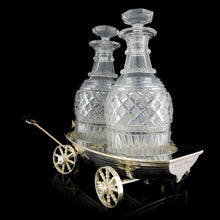Jolly Boat Double Decanter Stand, 1850
- Regular price
- £4,400
- Sale price
- £4,400
- Regular price
-
- Unit price
- /per
Adding product to your cart
Overall length: 47cm (18.5in)
Silver on copper. A double decanter stand in the form of clinker-built jolly boat, inset with circular recesses for decanters and stoppers, fitted with a wheeled carriage and rope twist attachment for ease of movement around the dining table. The transom engraved with ‘Jolly Roger’. Complete with a pair of George III cut glass decanters with stoppers.
As a whole Jolly boat decanter stands originate from the period of the French Revolutionary War and the Napoleonic Wars when they became the prized possessions of successful Royal Navy officers. Taking the form of the smallest boat carried on a warship of the period, the decanter stand of this type gives a glimpse into the shipboard dining customs of officers in Nelson’s navy. It was customary at the table after pouring wine or spirit from the decanter, to return it to the stand and push it along to the next officer. It is believed that the saying ‘to push the boat out’ has its origins in the custom as the officer paying for the wine was the first to start the jolly boat off round the table.
Read more
The earliest known jolly boat coasters that can be precisely dated bear the silver hallmark date of 1799 (Dawson, W. R., (1932) ‘The Nelson collection at Lloyd’s’). Of the few examples that are known nearly all are Sheffield plate (silver on copper) and thus unmarked. The National Maritime Museum refers to an example belonging to Captain George Murray, RN (d.1819) that can confidently be dated to his period of command of HMS Edgar, 1801-1803. Examples sold by The Armoury include one made for Captain Frederick Maitland, RN, who in July 1815 accepted the formal surrender of Emperor Napoleon Bonaparte on board HMS Bellerophon; and a pair made for Captain Henry Blackwood, RN, who with Captain Hardy of the Victory was witness to Nelson’s will in the hours before the Battle of Trafalgar; and a later example formerly belonging to Lieutenant-General James Thomas Brudenell, 7th Earl of Cardigan (1797-1868), who led the Charge of the Light Brigade to destruction in the Crimea in October 1854 and eschewed the wind-swept camp of his brigade for the comfort of his luxury racing yacht Dryad moored in Balaclava harbour.














